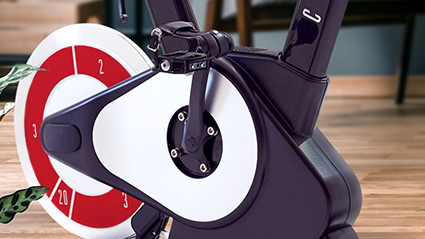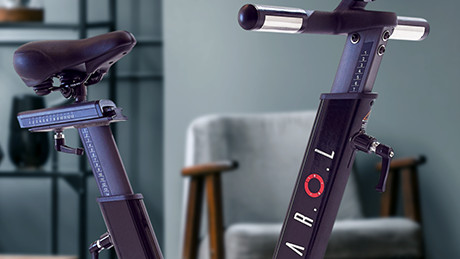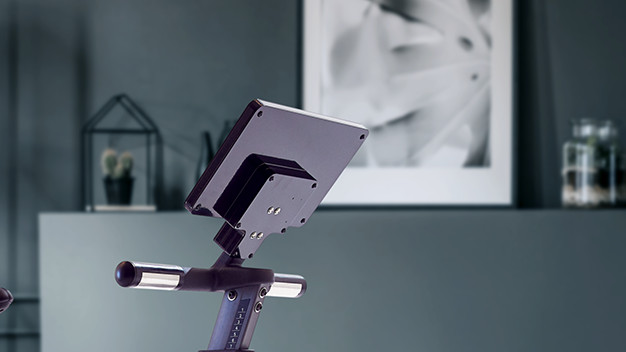Carol Exercise Bike
Two-minute review
The Carol is a high-tech spinning bike for high-intensity interval training (HIIT) that requires you to exercise for just nine minutes at a time. It's a pleasure to ride, reacting in real time to your efforts to give you an optimized workout – if your wallet can stand it.
The Carol, which stands for Cardiovascular Optimization Logic, is an AI-powered exercise bike that uses biometric data to create highly customized workouts. Using REHIT (reduced exertion high intensity training) Carol’s built-in tech works by calculating the user’s resistance levels, which in turn helps provide the ideal programme for you.
It’s extremely expensive, so won't appeal to everybody, but as one of the most high-tech pieces of fitness equipment on the market, it is certainly one to push the industry forward. And that is what sets Carol back from all the rest – the main workout offered is just eight minutes and 40 seconds long. And the experts say you just need to do it three times a week for eight weeks to see health and fitness benefits.
This bike is ideal for the time poor, those new to exercise or people getting over injuries. It’s also really easy to use as the intelligence works by adapting the pedal power to whoever is riding it. In other words, it automatically adjusts the resistance depending on how well you're spinning – exposing fitter users to more resistance and reducing it for those struggling.

In order to get to the individual programmes, you have to put Carol through a series of six calibration rides. It doesn’t matter when you do them, but we spread them out over a week. This enables the bike to calculate your baseline fitness and a suitable level of resistance.
Then you can choose from a variety of four preset workouts. The intense workout setting requires eight minutes and 40 seconds, consisting of two 20-second sprints punctuated by minutes of warm-up and warm-down and then three others. Fat-Burn 30, an endurance ride where you generate massive ‘after burn’ and which is proven to help lose nine times more fat than regular exercise, gives you the option of a 30 sprint (15 mins) or 60 sprint (25 mins) ride. Both options involve eight-second sprints at personalized resistance followed by 12-second rests.
Price and availability
The Carol Exercise Bike starts at $2,395 / £2,195 (about AU$4,000), plus delivery charges, with an additional $12 / £12 (about AU$15) monthly subscription fee. It's currently available in the US, UK and Canada, though the company may ship outside those countries by special arrangement if it's practical.
For context, Peloton's exercise bikes start at $1,895 / £1,750 (about AU$2,500), with a monthly subscription fee of $12.99 / £12.99 (about AU$17).
Both offer a free trial period so you can try the bike and service before committing to the full subscription.
Design
The Carol Exercise Bike is sleek and slim; we found it a lot less bulky than other spinning bikes we've used. It features a black steel frame, a fairly small touchscreen tablet and, although quite heavy, is fairly easy for two people to move, as it has two wheels.
Measuring 42.5 x 22 inches and weighing 130 pounds, it's small enough to fit in rooms with little space. Although it doesn’t provide any additional space for water bottles etc, this reduces its footprint.
The stand-out feature of the bike is by far its built-in software which includes computer-controlled breaks. In fact, every bit of the bikes design is focused on your safety; from its software that offers safety algorithms that will warn you if your heart rate is unusually high and the heart rate monitors on the handlebars, and sensors to measure your cadence (how fast you're pedalling, measured in rotations per minute, or RPMs) and resistance level.
When it comes to the pedals, the Carol Bike offers a toe cage for secure footing while wearing regular workout sneakers or – as the company suggests – any footwear (even high heels). Alternatively, you can clip in with SPD bike shoes.

Performance
Before you can actually take part in your first proper ride, you’ll need to put yourself through six separate ones as part of the set up process. These introductory rides are designed to help familiarize you with the system and for the software to know how hard to push you. These rides provide the bikes algorithms to calculate the amount of resistance required for you to reach your maximum intensity. Carol's AI then continues to monitor your metrics and tweak your resistance as and when needed in a bid to help improve your fitness.
Although it's unusual not to be able to jump right into a fitness programme, the six day period helped us understand the science behind the bike and get to grips with it. We actually enjoyed the 'learner' rides as such as it helped us understand the mechanisms of the bike.
Once you're ready to begin your programme, there are a few rides to choose from. The intense rides are exactly that – intense. They start with a gentle warmup, followed by a 20-second sprint, a recovery period, another 20-second sprint, a cooldown, and you're done. The entire workout lasts just under nine minutes. Trust us, it is not as easy as it sounds for during those 20-minute sprints you cycle so fast, it's difficult to catch your breath.
These short workouts, according to the bike's manufacturers, deliver the same benefits as a 45-minute run, and that completing just three intense rides a week for eight weeks has "been scientifically proven to deliver double the health and fitness gains of regular exercise." Having put ourselves through the rides now on numerous occasions, we're not surprised. These REHIT workouts aim to trigger your body's 'fight or flight response', causing it to burn the glycogen stored in your muscles as fuel.

As for how you 'perform' on your ride, the stats are there to see on the screen. After the first sprint, a graph appears with a blue line representing your power throughout the 20-second effort. The graph highlights your peak power score, giving you a goal to beat on the second sprint. After your second sprint, it will add a red line to the graph showing your performance for that effort, so you can easily see if you did better or worse.
To give you something to focus on during the time you are not killing yourself on the sprints, Carol offers a breath pacer at the top of the screen, guiding you how to breathe correctly in between the sprints. This was a drawback for us as despite trying to follow the guide, we couldn’t do it. In fact, one time it made us dizzy to puff out our breath for so long.
The choice of music is also very poor so again, another negative. That aside, we enjoyed the feeling we had after our rides; pushing ourselves so intensely for such a short period of time was manageable and left me feeling energised for the whole day.
We didn’t see our weight decrease much – maybe a pound or two, which could have easily been a fluctuation in water weight – but without a doubt, our fitness levels improved.
Buy it if
You're short of space
The Carol has a relatively small footprint, making it a practical choice if room is limited at home.
You need to keep quiet
If you want to avoid disturbing family and neighbors, the Carol is one of the quietest home workout machines around.
Time is limited
The short but seriously intense sessions mean you can get a proper workout that fits in around your other commitments.
Don't buy it if
You're on a tight budget
You can pick up a good quality conventional spin bike if you don't mind foregoing the smart tech, and pair it with a service like Strava for a cheaper alternative.
You love working out to music
The Carol suffers from a lack of good, varied tunes. Other subscription workout services have established deals with record labels to get a good range of songs, but this is sadly lacking here.
- We've tested, rated and ranked the best fitness trackers
0 comments:
Post a Comment